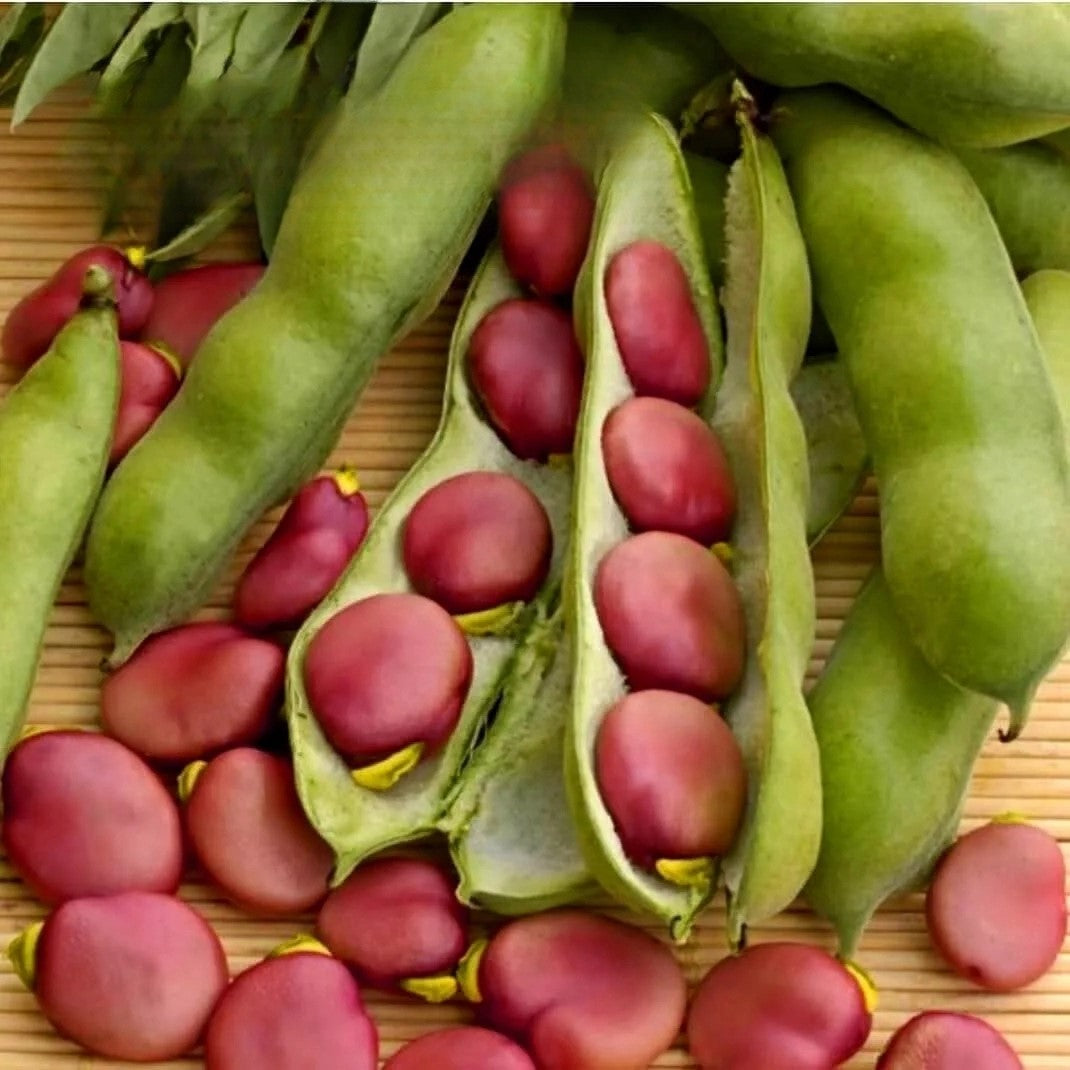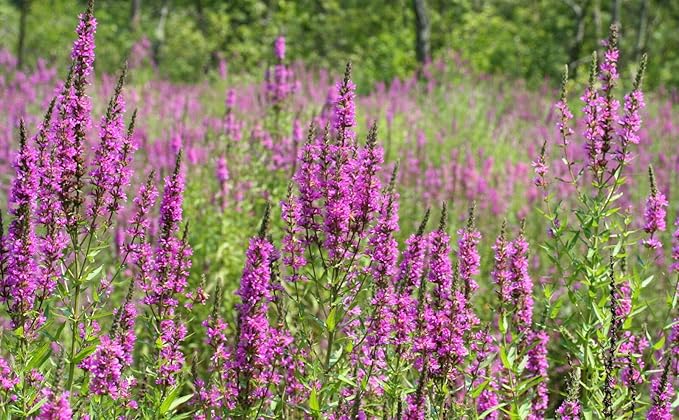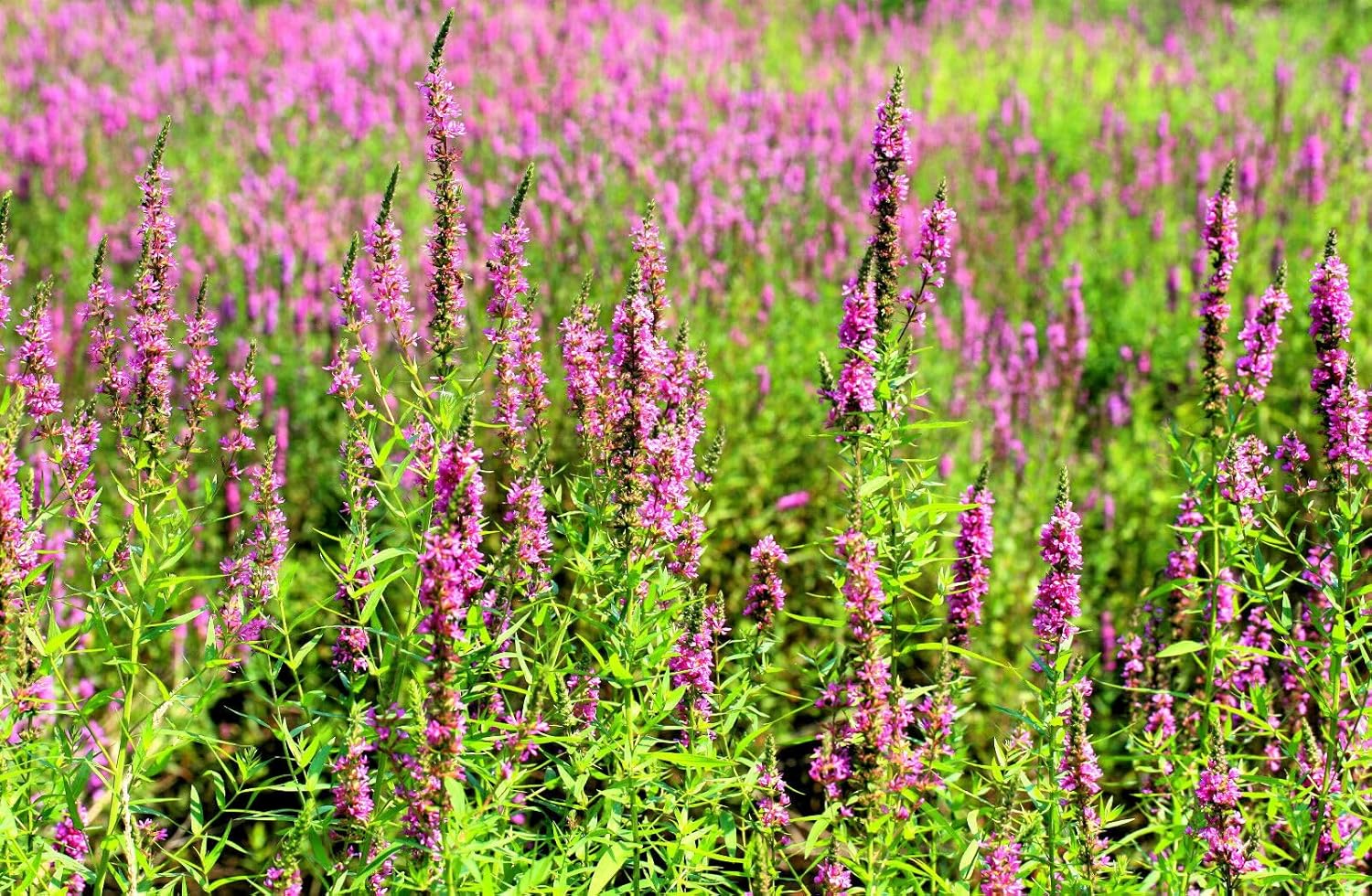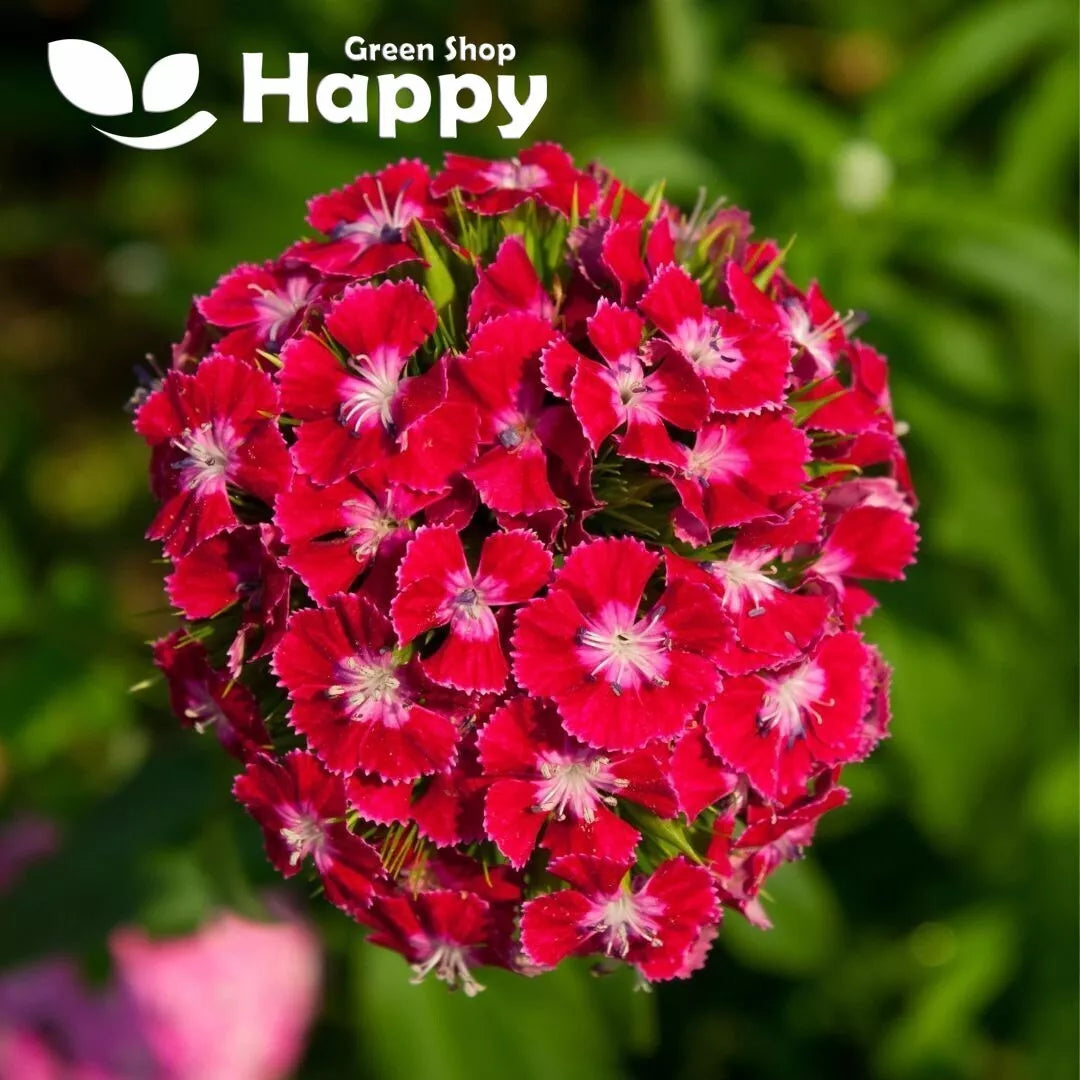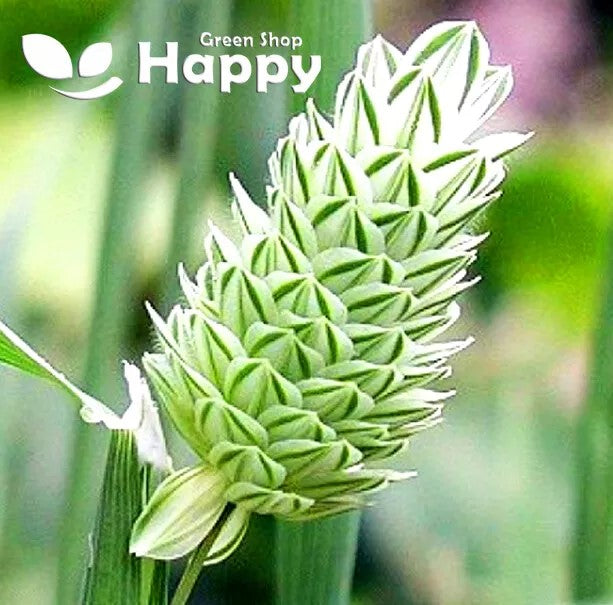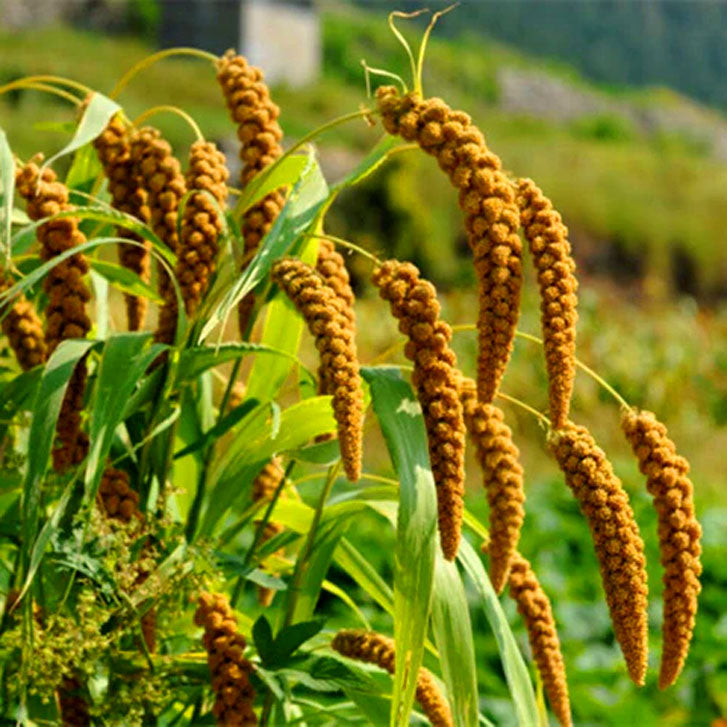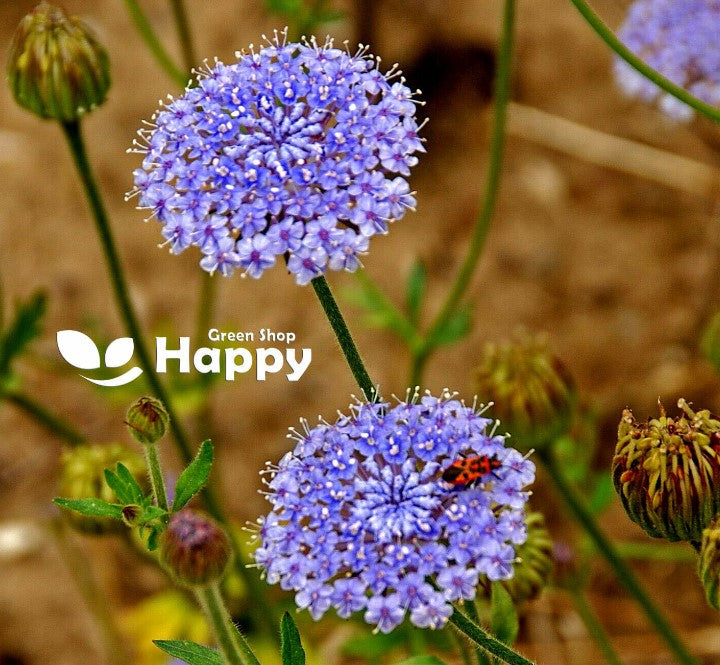Sort by:
299 products
299 products
Purple Loosestrife Seeds (Lythrum salicaria)
A striking perennial, Purple Loosestrife produces tall spikes of vibrant purple flowers throughout summer. Hardy and long-flowering, it adds vertical interest and color to borders, wetlands, and naturalistic garden plantings, attracting bees and butterflies.
What Makes It Special
-
Tall spikes of vivid purple flowers
-
Hardy, long-lasting perennial with dramatic vertical presence
-
Attracts pollinators, supporting wildlife-friendly gardens
Key Features
-
Botanical name: Lythrum salicaria
-
Hardy perennial
-
Height: 100–150 cm (3–5 ft)
-
Bloom time: Summer
Ideal For
-
Garden borders and wetland-style plantings
-
Naturalistic and cottage-style gardens
-
Pollinator-friendly landscapes
Sowing
-
Sow indoors Feb–Apr or outdoors Mar–May
-
Cover lightly with soil and keep moist
-
Germination: 14–28 days at 15–20°C
-
Thin seedlings 30–40 cm apart
-
Flowers in the first or second season after sowing
Sweet William Scarlet Seeds (Dianthus barbatus Red)
Sweet William Scarlet is a vibrant biennial flower renowned for its rich, scarlet-red flower clusters. With upright growth and densely packed blooms, it is perfect for borders, cottage gardens, and cut flower arrangements. This hardy biennial adds striking color and charm to any garden space.
What Makes It Special
-
Produces vivid scarlet-red flower clusters
-
Compact, upright growth ideal for borders and mixed beds
-
Excellent for cut flowers with long-lasting blooms
-
Biennial: reliable flowering in the second year
Key Features
-
Botanical name: Dianthus barbatus
-
Common name: Sweet William Scarlet
-
Seed count: Approx. seeds per pack
-
Height/Spread: 30–50 cm tall, 20–30 cm spread
-
Position: Full sun to partial shade, well-drained soil
-
Flowering period: Second year; late spring to early summer
-
Lifespan: Biennial
Ideal For
-
Borders, cottage-style gardens, and mixed flower beds
-
Cut flower arrangements
-
Pollinator-friendly gardens
-
Containers and patio planting
Sowing Instructions
-
When to sow:
-
Indoors: February–April for transplanting
-
Outdoors: April–May in well-prepared soil
-
-
How to sow:
-
Sow seeds thinly on the surface and press lightly into soil
-
Keep soil moist until germination (10–20 days)
-
-
Transplant/Thin: Space seedlings 20–30 cm apart
-
Care: Protect young plants from frost; deadhead spent flowers to prolong bloom
Sweet William 'Auricula Eyed' Mix Seeds (Dianthus barbatus)
Sweet William 'Auricula Eyed' is a biennial flower prized for its clusters of fragrant blooms with contrasting “eye” centers. This mix offers a variety of vivid colors, making it perfect for borders, cottage gardens, and pollinator-friendly plantings. Its upright growth and dense flower clusters add dramatic color and charm to any garden setting.
What Makes It Special
-
Produces dense clusters of fragrant, bi-colored flowers
-
Attractive to bees, butterflies, and other pollinators
-
Compact, upright growth ideal for borders and mixed beds
-
Biennial: provides a reliable display in the second year
Key Features
-
Botanical name: Dianthus barbatus
-
Common name: Sweet William 'Auricula Eyed'
-
Seed count: Approx. seeds per pack
-
Height/Spread: 30–50 cm tall, 20–30 cm spread
-
Position: Full sun to partial shade, well-drained soil
-
Flowering period: Second year; late spring to early summer
-
Lifespan: Biennial
Ideal For
-
Borders, cottage-style gardens, and mixed flower beds
-
Cut flower arrangements
-
Pollinator-friendly gardens
-
Containers and patio pots
Sowing Instructions
-
When to sow:
-
Indoors: February–April for transplanting
-
Outdoors: April–May in well-prepared soil
-
-
How to sow:
-
Sow seeds thinly on the surface and press lightly into soil
-
Keep soil moist until germination (10–20 days)
-
-
Transplant/Thin: Space seedlings 20–30 cm apart
-
Care: Protect young plants from frost; remove spent flowers to prolong bloom
Mexican Feather Grass Seeds (Stipa tenuissima)
Mexican Feather Grass is a delicate and elegant ornamental grass known for its fine, wispy foliage and soft, flowing plumes. Its graceful movement in the wind and silvery-green foliage makes it a standout in borders, rock gardens, or naturalistic landscapes. This low-maintenance grass also works beautifully in cut and dried flower arrangements.
What Makes It Special
-
Ultra-fine, feathery foliage that sways with the breeze
-
Creates a soft, flowing texture in gardens and containers
-
Adds a naturalistic, meadow-like effect
-
Excellent for fresh or dried floral arrangements
Key Features
-
Botanical name: Stipa tenuissima
-
Common name: Mexican Feather Grass
-
Seed count: Approx. seeds per pack
-
Height/Spread: 30–60 cm tall, 20–40 cm spread
-
Position: Full sun, well-drained soil
-
Flowering period: Summer
-
Lifespan: Annual or short-lived perennial in mild climates
Ideal For
-
Ornamental borders and rock gardens
-
Containers and patio pots
-
Naturalistic or meadow-style plantings
-
Cut flowers and dried arrangements
-
Low-maintenance gardens with texture and movement
Sowing Instructions
-
When to sow: March–May outdoors after frost, or indoors 4–6 weeks earlier
-
How to sow:
-
Scatter seeds on prepared soil and press lightly
-
Do not cover too deeply; seeds need light for germination
-
Keep soil lightly moist until seedlings appear (14–21 days)
-
-
Spacing: Thin seedlings to 20–30 cm apart
-
Care: Very low-maintenance; tolerates dry, poor soils and full sun
Blue Tansy Lacy Seeds (Phacelia tanacetifolia)
Blue Tansy Lacy is an annual flowering plant celebrated for its delicate, lacy foliage and vibrant blue flowers. This fast-growing plant is a favorite for pollinator gardens, attracting bees, butterflies, and other beneficial insects. Its feathery foliage and bright blooms also make it excellent for borders, wildflower meadows, and cut-and-dried arrangements.
What Makes It Special
-
Stunning sky-blue flowers on tall, graceful stems
-
Lacy, aromatic foliage adds texture and interest to the garden
-
Highly attractive to bees and other pollinators
-
Quick to establish and easy to grow from seed
Key Features
-
Botanical name: Phacelia tanacetifolia
-
Common name: Blue Tansy, Lacy Phacelia
-
Seed count: Approx. seeds per pack
-
Height/Spread: 60–90 cm tall, 30–40 cm spread
-
Position: Full sun, well-drained soil
-
Flowering period: Summer
-
Lifespan: Annual
Ideal For
-
Pollinator and wildlife gardens
-
Borders, meadows, and naturalistic plantings
-
Cut flower and dried arrangements
-
Companion planting to improve soil and attract beneficial insects
Sowing Instructions
-
When to sow: March–May outdoors, or start indoors 4–6 weeks earlier
-
How to sow:
-
Sow thinly in prepared, well-drained soil
-
Lightly cover with soil (0.5 cm)
-
Keep soil moist until seedlings emerge (7–14 days)
-
-
Spacing: Thin to 30–40 cm apart once established
-
Care: Low-maintenance; tolerant of poor soils and drought once established. Deadhead to prolong flowering.
Ornamental Grasses Mix Seeds
(Phalaris canariensis, Panicum violaceum, Setaria italica, Setaria verticillata)
A carefully selected blend of ornamental and bird-friendly grasses, this mix combines Canary Grass, Violet Millet (Panic Grass), Foxtail Millet, and Bristle Grass. Together, they create textured plantings with unique seed heads that sway beautifully in the breeze, while also serving as a natural food source for wild birds.
What Makes It Special
-
A diverse blend of textures, seed heads, and heights for garden interest
-
Excellent for cut and dried flower arrangements
-
Wildlife-friendly, producing nutritious seeds that attract birds
-
Easy to grow in a variety of soils and conditions
Key Features
-
Species included:
-
Phalaris canariensis (Canary Grass)
-
Panicum violaceum (Violet Millet)
-
Setaria italica (Foxtail Millet)
-
Setaria verticillata (Bristle Grass)
-
-
Height: 50–150 cm depending on species
-
Position: Full sun, well-drained soil
-
Use: Ornamental, bird seed production, fresh or dried floral work
-
Lifespan: Annual grasses
Ideal For
-
Ornamental borders with movement and texture
-
Naturalistic or wildlife-friendly gardens
-
Bird lovers providing natural seed feed
-
Cut and dried flower arrangements
-
Agricultural or mixed planting use
Sowing Instructions
-
When to sow: March–May outdoors after frost, or under cover earlier
-
How to sow:
-
Scatter directly into prepared soil in a sunny, open site
-
Cover lightly (0.5–1 cm) with soil
-
Water gently and keep moist until germination (7–14 days)
-
-
Spacing: Thin seedlings to 20–30 cm apart
-
Care: Minimal maintenance required; thrives in full sun
Canary Grass Seeds (Phalaris canariensis)
Canary Grass is a fast-growing annual grass valued both as an ornamental plant and as a seed source for cage birds such as canaries, finches, and budgerigars. With its upright stems and dense, oval-shaped seed heads, it adds texture to gardens and is especially popular for wildlife plots and dried floral arrangements.
What Makes It Special
-
Produces dense, oval-shaped seed heads attractive in borders and dried bouquets
-
Seeds are highly nutritious, making it an excellent choice for bird feed
-
Quick and easy to grow, even for beginners
-
Thrives in most soils with minimal care
Key Features
-
Botanical name: Phalaris canariensis
-
Common name: Canary Grass
-
Seed count: Approx. seeds per pack
-
Height/Spread: 60–120 cm tall, 20–40 cm spread
-
Position: Full sun, well-drained soil
-
Flowering/Seeding period: Summer to early autumn
-
Lifespan: Annual grass
Ideal For
-
Bird seed production (canaries, finches, budgerigars)
-
Ornamental borders
-
Fresh and dried floral arrangements
-
Wildlife-friendly gardens
-
Agricultural use as a grain crop
Sowing Instructions
-
When to sow: March–May outdoors after frost, or under cover earlier for transplanting
-
How to sow:
-
Sow directly into prepared soil in a sunny location
-
Cover lightly with soil (0.5–1 cm deep)
-
Water gently to keep soil moist until germination (7–14 days)
-
-
Spacing: Thin or transplant seedlings 20–30 cm apart
-
Care: Requires little maintenance; thrives in sun and tolerates a range of soils
Foxtail Millet Seeds (Setaria italica)
Foxtail Millet is an ornamental and agricultural grass grown for its distinctive bushy, bottlebrush-like seed heads that resemble a fox’s tail. It is valued for both decorative use in floral arrangements and as a grain crop for food, birdseed, and forage. Its tall, upright stems and graceful flower spikes add structure and texture to garden borders, wildlife plots, and dried bouquets.
What Makes It Special
-
Produces attractive foxtail-like seed heads
-
Versatile: grown for ornamental, edible, and forage uses
-
Excellent for dried or fresh floral arrangements
-
Easy to grow, drought-tolerant and hardy
Key Features
-
Botanical name: Setaria italica
-
Common name: Foxtail Millet
-
Seed count: Approx. seeds per pack
-
Height/Spread: 90–150 cm tall, 30–50 cm spread
-
Position: Full sun, well-drained soil
-
Flowering period: Summer to autumn
-
Lifespan: Annual grass
Ideal For
-
Ornamental borders
-
Fresh and dried floral arrangements
-
Wildlife gardens (birds love the seed heads)
-
Grain production and forage
-
Naturalistic or prairie-style planting
Sowing Instructions
-
When to sow: April–June outdoors after frost, or start indoors 4–6 weeks earlier
-
How to sow:
-
Sow directly into well-drained soil in a sunny spot
-
Cover lightly with soil (depth 0.5–1 cm)
-
Keep moist until germination (7–14 days)
-
-
Spacing: Thin or transplant to 30–40 cm apart
-
Care: Low maintenance; thrives in heat and tolerates dry soil once established
Blue Lace Flower Seeds (Didiscus caeruleus / Trachymene caerulea)
The Blue Lace Flower is an elegant and delicate annual, much loved for its airy umbels of soft sky-blue blossoms. Each flower head resembles lacework, carried on long slender stems, making it ideal for cutting. With its light, lacy texture, this plant brings charm and movement to borders, cottage gardens, and wildflower-style plantings. It is also a superb choice for floral arrangements, both fresh and dried.
What Makes It Special
-
Produces lace-like umbels of pastel blue blooms
-
Excellent cut flower with a long vase life
-
Attractive to bees, butterflies, and pollinators
-
Adds a soft, romantic touch to borders and bouquets
Key Features
-
Botanical name: Didiscus caeruleus / Trachymene caerulea
-
Common name: Blue Lace Flower
-
Seed count: Approx. seeds per pack
-
Height/Spread: 45–60 cm tall, 20–30 cm spread
-
Position: Full sun, well-drained soil
-
Flowering period: Summer to early autumn
-
Lifespan: Half-hardy annual
Ideal For
-
Cottage gardens
-
Wildflower meadows
-
Borders and mixed beds
-
Cut flower and dried arrangements
-
Pollinator-friendly gardens
Sowing Instructions
-
When to sow: March–May indoors, or April–June outdoors after frost has passed
-
How to sow:
-
Sow seeds thinly in trays with seed compost or directly outdoors in fine soil
-
Lightly cover seeds with a thin layer of soil or vermiculite
-
Keep moist until seedlings appear (14–21 days)
-
-
Transplant/Thin: Space plants 20–30 cm apart
-
Care: Deadhead to prolong flowering; provide support in windy sites
Showing 270/299

